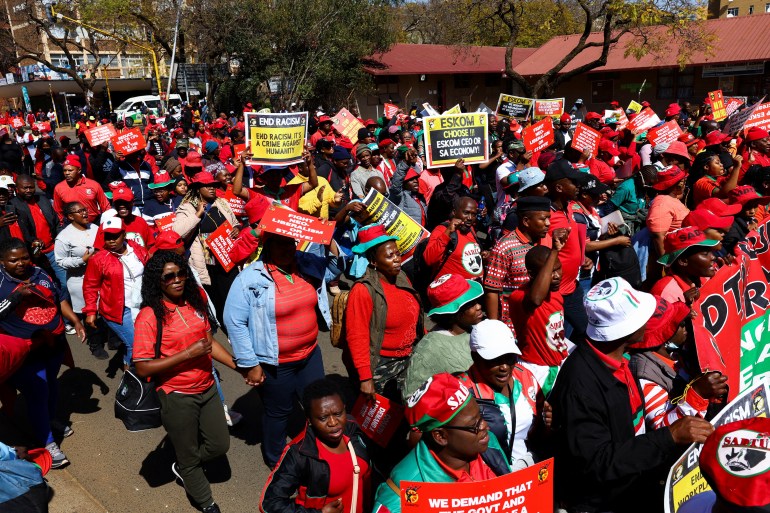Cost of living: Choosing between bread and phone data in S Africa
In the world’s most unequal country, a factory worker tries to make ends meet and raise awareness about workers’ rights.

This story is part of a series exploring how the cost-of-living crisis is affecting people around the world.
Johannesburg, South Africa – It is cold and dark when 53-year-old factory worker Letta Nkabinde leaves her home in Ivory Park at 5am to begin her hour-long commute to work.
Keep reading
list of 4 itemsCost of living: A Dutch woman plans to forego heating come winter
Cost of living: ‘How to manage?’ laments Sri Lankan market vendor
Cost of living: ‘Blood, sweat’ for a Seoul food delivery driver
She tucks her handbag beneath her coat to keep it hidden from the thieves who are known to lurk in this working-class Johannesburg neighbourhood, waiting for targets, before walking 10-15 minutes to the nearby taxi stand to catch a 16-seater minibus to the wealthy area where she works in a factory that manufactures cosmetics.
“The morning shift starts at 6am sharp, so I have to get up very early,” says Letta who is wearing a formal red jacket and crimson lipstick. “I know workers that wake up at 3am every day to get to work on time because they have to walk a longer distance to reach taxis. It’s very difficult.”
South Africa is the most unequal country in the world, according to the World Bank, which in a recent report highlighted how the historically unequal distribution of land “undermines rural development and entrepreneurship” and leaves Black South Africans, women-headed households, and unemployed people with the highest rates of poverty and income inequality.
Letta’s community in Ivory Park, a densely populated area where nearly 98 percent of the residents are Black, is one of the poorest in South Africa. Nearly 30 years after the end of apartheid, poorer communities continue to live with the harsh reality of segregated spatial dynamics, which began when apartheid-era laws forced different races to live in different areas, relegating people of colour – especially Black people – to those furthest from the urban centres where they could find employment.
The roads surrounding Ivory Park’s modest homes and corrugated informal dwellings are unpaved; some of them have potholes that have filled with water and sewage, and taxis refuse to pick up commuters from their streets to avoid tire damage.
But Letta does not mind the daily walk from home to reach a minibus taxi, she says, despite the threat of bad weather and crime. “That’s not the worst of it for me, the bigger problem is that public transport has become unaffordable.”
In previous years, the single mother of three used to budget about 900 rand ($51) for transportation every month; she now spends 1,200 rand ($68) per month and worries that the cost will only rise.
“Taxis are always increasing because of the rising cost of fuel. Towards month-end, you are struggling to go to work because you don’t have money for transport,” she explains.

‘Rising cost of living’
Letta works as a production line operator for a global cosmetics manufacturing brand based in the affluent area of Midrand, about 10km (6.2 miles) from Ivory Park. She has spent 25 years working daily eight-hour shifts at the same factory and earns 70.83 rand ($4) per hour. Her net monthly income is 17,000 rand ($959) but she takes home approximately 13,000 rand ($733) per month after tax deductions. Although this is better than the minimum wage in South Africa (23.19 rand or just more than $1 per hour), she says it “is barely enough to get by”.
The rising cost of goods and services has had a particularly harsh impact on workers like Letta, whose salary has remained stagnant for years.
“Companies don’t want to talk about wage increases any more, they just tell you about COVID and its impact,” she says, “As a worker, especially as a single parent, and a woman, it makes life very difficult.”
Letta supports her thee children – aged 30, 21 and 12 – as the family’s main breadwinner. Her two adult children live at home with her while they study and look for employment in South Africa’s dwindling job market. Her youngest daughter, she says with beaming pride, “is smart, she is not like children her age who demand ridiculous things because of what their friends have, she understands that as a single parent, I give them my best, and what I don’t offer them is beyond control”.
“It is difficult to take care of yourself and your children these days. We really can’t afford comfort any more, we are down to basics, and you must make tough choices,” says Letta, with a concerned expression. “Think about the current food inflation price, these days you have to choose between bread and things like [mobile phone] data or entertainment.”

The annual rate of consumer inflation grew from 7.4 percent in June to 7.8 percent in July, the highest rise in 13 years according to Stats SA, the government’s department of statistics. The largest contributors to food inflation, according to the report, are “oils and fats, electricity, fuel, and bread and cereals”.
In June, South African President Cyril Ramaphosa acknowledged the unbearable cost of living in his newsletter, stating, “the most basic foodstuffs cost more now than a year ago.”
He further attributed the price increases, particularly those for fuel and food, to the continuing conflict between Russia and Ukraine and claimed that these developments “are the result of circumstances over which we have little control.”
Since South Africa trades with both Russia and Ukraine, the human cost of the conflict is being felt by the general populace. The deputy minister of finance, David Masondo, told a parliamentary committee in March that, “much of what has been affected is wheat, maize, and oil supplies. The increase in [the] price of these household staples has added to inflation and reduced the disposal income of consumers”.
But Letta believes the government could be “doing more on issues that they can control” such as the price of household electricity.
In South Africa, government municipalities are largely responsible for distributing electricity to households after acquiring it from Eskom, the country’s power utility. The tariffs Eskom charges municipalities are a significant factor in the cost of electricity, according to the most recent research conducted by Stats SA.
The report also claims that since the introduction of rolling national blackouts in 2007, which resulted in a “loss of economic output” of roughly 500 million rand (about $28m) per blackout every day in 2020 and is thought to be a contributing factor in the loss of more than one million job opportunities, electricity rates have risen dramatically.
“I now spend about 500 rand ($28) on electricity every month, half of that used to be enough for me and my family,” says Letta.
“They tell you to save electricity consumption, but as much as we can try to lessen the amount of electricity we use in our homes, it doesn’t work,” she emphatically explains. “We turn off the television when we go to sleep, we even turn off the fridge when we go to sleep to try and save but you’ll wake up the next morning and find less units.”
‘By the grace of God’
Letta had a difficult childhood. She was born during apartheid in what is now Mpumalanga province, to the east of Johannesburg.
Raised by a working single mother, she remembers moving from one home to another, staying with “many families” until her mother got a house in an informal settlement in Johannesburg, but then being forced back to the rural areas when they lost that home.
“I’d say that I grew up like an orphan. I did not have a proper family so really I grew by the grace of God,” says Letta.
She dropped out of school after the 12th grade and started working the same year at just 18 years old. The idea that “when you are a woman, you must fend for yourself because no one will fend for you,” has always been ingrained in her, which forced her to mature quickly.
“I struggled to find a job after I left high school, so I started a small business. I would sell potatoes, oranges, mielies, on some days and then find piece jobs like babysitting, at the same time,” she says.
It wasn’t until she was 28 years old that she managed to get a steady job – working in the factory where she still works today, after almost a decade of experiencing income insecurity as an informal worker.

Although Letta considers herself a middle-income earner – defined by the South African Department of Human Settlements and Water Sanitation as individuals who earn between 3,501 rand ($197) and 22,000 rand ($1,241) per month – she contends that the country’s middle class is “living from paycheque to paycheque.”
“You know, before you were able to invest, you had money to keep aside, but not any more. It is impossible to save now. How do you save what you don’t have?” Letta laughs.
“We are the non-existent middle class. We do not qualify for government assistance, but we cannot afford many basics,” she says. “But do you know what they say we can afford? Debt.”
Union work
In August, Letta, who doubles as a worker representative in the factory for the grassroots General Industries Workers Union of South Africa (GIWUSA), swapped her factory garments for a red t-shirt and a pair of casual sneakers.
She took part in a national demonstration that was arranged by workers at the Union Buildings in Pretoria, the nation’s capital, with the support of 200 unions and civil society organisations. In major cities around the country, 5,000 protesters marched in support of increased pay, lower fuel prices, and government action to address the skyrocketing prices of basic needs and services.
The high turnout reveals the rising discontent and desperation among the country’s labour force about the cost of living.
“The protest was very important. The government should be aware that workers are suffering. When we are quiet, the government also keeps quiet. They need to understand what we are going through,” says Letta.
She often faces an uphill battle as both an employee and an advocate for workers, she explains, “I act as the middle woman between management and employees. If there’s a problem on the side of employees, I work on those complaints with management. And if the management has a problem, they also come to me.”
Letta acknowledges that the rising cost of living is “challenging to both companies and workers,” but she also thinks that individuals who educate themselves about the value of their labour and demand what they are entitled to may help bring about change.
“I’ve learned that as workers, we don’t know our rights. We don’t know what we are owed for our labour or our value,” she says. “I’m trying to bring awareness. Unions help us exercise our rights and I want to teach workers that.”